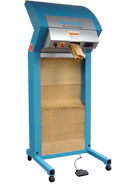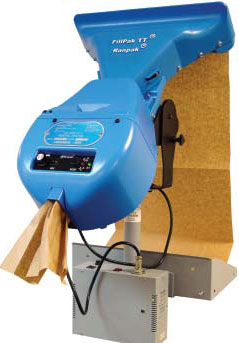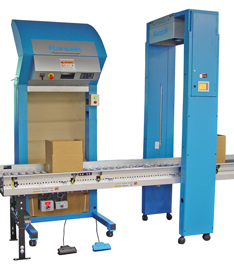Ranpaks Sustainable Practices and Focus on Paper Products
Last updated on

Ranpak has always focused on paper solutions, and they feel a strong sense of responsibility to protect our environment. The environmental friendliness of packaging depends on many factors, like the presence of hazardous substances, the energy that is needed to extract, process and dispose the materials, and the emission of gasses that are released during this process.
Taking all these factors in consideration, Ranpak’s choice of a kraft paper system is an easy one. The paper is made from a natural renewable source, unbleached, biodegradable, decomposable and recyclable.
But fundamentally, Ranpak has always focused on paper, because they strongly believe that it is a superb and highly flexible packaging material that can be used in many ways. When used in the right way, paper has remarkable cushioning characteristics and is able to protect a great variety of products. In addition to cushioning, paper is a good alternative for void filling, both from a handling as from an environmental point of view.
PAPER PACKAGING MATERIAL
• Ranpak paper is made from allnatural kraft paper that is 100% biodegradable, recyclable and renewable
• Ranpak paper is available with up to 100% recycled content
• Ranpak paper can be easily recycled along with used corrugated boxes, newspapers or other paper waste
• Most of the virgin pulp material used in Ranpak’s paper is derived from sawmill residuals (left over wood chips after the dimensional lumber is cut from a log). These are domestic trees, primarily pine and fir, harvested then replanted for the lumber and building material industry
• Ranpak works with SFI Certified paper suppliers ensuring our paper comes from a responsible source, backed by a rigorous, third-party certification audit – Ranpak’s paper suppliers must also comply with the Lacey Act which prevents illegal logging practices
– Paper scrap and cardboard cores
– Plastic from obsolete machinery
– Returned machinery
– Used equipment oil
• Preventative maintenance is performed routinely on all paper converting equipment to optimize uptime and energy efficiencies
• Scrap metal from the machines is separated and sold for reuse
– Scrap is stored on site until a full truck load is available maximizing fuel efficiencies
• Ranpak continuously reviews our manufacturing processes to see where waste can be reduced and minimized
• 5 manufacturing facilities located worldwide to optimize shipping distances to our distributors while reducing the carbon footprint
• Most of Ranpak’s products can be double-stacked for optimized truck space utilization
• Navigation software is available to all of Ranpak’s external sales force and service technicians to optimize
trips for increased fuel efficiency and a lower carbon footprint
• Ranpak maintains a fleet of high-efficiency vehicles that are constantly updated ensuring the best fuel efficiency
• Ranpak offers free package design to all of our customers ensuring the optimal amount of material is used to maximize container space and transportation costs
• Paper recycle bins located in all common areas to encourage employee recycling
• Employees are encouraged to turn off lights and computer equipment when not in use for increased energy savings
• Outsourced collateral material is printed on papers certifi ed by FSC suppliers
• All obsolete computer equipment is recycled
– Used toner cartridges are sent back to the manufacturer for recycling
• HVAC system is computer regulated to optimize heating/air conditioning usage and to save energy
• High efficiency toilets have been installed to reduce water usage and wastewater costs
• Printers have been programmed to use the 2-sided printing option as the default setting to reduce paper usage
Disposal
Ranpak paper is 100% recyclable and biodegradable. It can be easily recycled along with used corrugated boxes, newspapers or other paper waste.
Renewable Source
Most of the virgin pulp material used in Ranpak’s paper is derived from sawmill residuals (left over wood chips after the dimensional lumber is cut from a log). These are domestic trees, primarily pine and fir, harvested then replanted for the lumber and building material industry.
Sustainable Source
The forest products industry plants more than 1.7 million trees per day, growing more than is harvested annually to ensure a reliable source of raw materials. Over the past 50 years, the forests in the U.S. have increased by nearly 40% and by 10 million acres between 1987 and 2002.
SFI Certified Paper Suppliers
Ranpak works with SFI Certified paper suppliers ensuring our paper comes from a responsible source, backed by a rigorous, third-party certification audit.
Most Popular Related Items
About VoidFillPackaging.com
Welcome to Void Fill Packaging, a site that showcases packaging systems, talks about packaging products, and what’s new in the industry. We provide a place for product research, discovery and discussion. Take a look around and be sure to stop by again to see whats new!Ranpak Paper Fact
Ranpak only works with Sustainable Forest Initiative (SFI) or Forest Stewardship Council (FSC) certified mills to ensure their material comes from a responsible source and that sustainable forestry practices are taking place.
Thanks to this sustainable forestry management, forests in the United States are growing every year. The forest products industry plants more than 1.7 million trees per day, growing more than is harvested each year. According to the Society of American Foresters, there are more trees now in the United States than there were in the 1920s.





The pulse of the packaging community